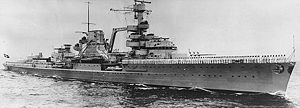German cruiser Leipzig

Leipzig, circa 1936
|
|
| History | |
|---|---|
|
|
|
| Laid down: | 28 April 1928 |
| Launched: | 18 October 1929 |
| Commissioned: | 8 October 1931 |
| Fate: | Scuttled July 1946 |
| General characteristics | |
| Class and type: | Leipzig-class cruiser |
| Displacement: | 8,100 t (8,000 long tons; 8,900 short tons) |
| Length: | 177 m (580 ft 9 in) |
| Beam: | 16.3 m (53 ft 6 in) |
| Draft: | 5.69 m (18 ft 8 in) |
| Propulsion: |
|
| Speed: | 32 knots (59 km/h; 37 mph) |
| Range: | 3,900 nmi (7,200 km; 4,500 mi) at 10 knots (19 km/h; 12 mph) |
| Complement: |
|
| Armament: |
|
| Armor: |
|
| Aircraft carried: | 2 × Arado 196 floatplanes |
| Service record | |
| Operations: | |
Leipzig was the lead ship of her class of light cruisers built by the German navy. She had one sister ship, Nürnberg. Leipzig was laid down in April 1928, was launched in October 1929, and was commissioned into the Reichsmarine in October 1931. Armed with a main battery of nine 15 cm (5.9 in) guns in three triple turrets, Leipzig had a top speed of 32 knots (59 km/h; 37 mph).
Leipzig participated in non-intervention patrols during the Spanish Civil War. In the first year of World War II, she performed escort duties for warships in the Baltic and North seas. While on one of these operations in December 1939, the ship was torpedoed by a British submarine and badly damaged. Repairs were completed by late 1940, when she returned to service as a training ship. She provided gunfire support to the advancing Wehrmacht troops as they invaded the Soviet Union in 1941.
In October 1944, Leipzig collided with the heavy cruiser Prinz Eugen; the damage was so severe that the navy decided complete repairs were unfeasible. The ship was patched up to keep her afloat, and she helped to defend Gotenhafen from the advancing Red Army in March 1945. She then carried a group of fleeing German civilians, reaching Denmark by late April. After the end of the war, Leipzig was used as a barracks ship for minesweeping forces and was scuttled in July 1946.
Leipzig was 177 meters (581 ft) long overall and had a beam of 16.3 m (53 ft) and a maximum draft of 5.69 m (18.7 ft) forward. She displaced 8,100 metric tons (8,000 long tons; 8,900 short tons) at full combat load. Her propulsion system consisted of two steam turbines and four 7-cylinder MAN two-stroke double-acting diesel engines, which were the basis for the unsuccessful US Navy Hooven-Owens-Rentschler design. Steam for the turbines was provided by six Marine-type double-ended oil-fired boilers. The ship's propulsion system provided a top speed of 32 knots (59 km/h; 37 mph) and a range of approximately 3,900 nautical miles (7,200 km; 4,500 mi) at 10 knots (19 km/h; 12 mph) using only the diesel engines. Leipzig had a crew of 26 officers and 508 enlisted men.
...
Wikipedia
